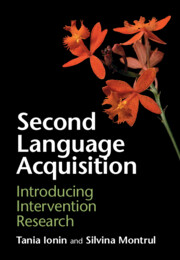114 results
Dedication
-
- Book:
- Second Language Acquisition
- Published online:
- 03 February 2023
- Print publication:
- 26 January 2023, pp v-vi
-
- Chapter
- Export citation
Brief Contents
-
- Book:
- Second Language Acquisition
- Published online:
- 03 February 2023
- Print publication:
- 26 January 2023, pp vii-viii
-
- Chapter
- Export citation
Copyright page
-
- Book:
- Second Language Acquisition
- Published online:
- 03 February 2023
- Print publication:
- 26 January 2023, pp iv-iv
-
- Chapter
- Export citation
6 - Subjunctive Mood
-
- Book:
- Second Language Acquisition
- Published online:
- 03 February 2023
- Print publication:
- 26 January 2023, pp 153-193
-
- Chapter
- Export citation
Glossary
-
- Book:
- Second Language Acquisition
- Published online:
- 03 February 2023
- Print publication:
- 26 January 2023, pp 325-341
-
- Chapter
- Export citation
Preface
-
- Book:
- Second Language Acquisition
- Published online:
- 03 February 2023
- Print publication:
- 26 January 2023, pp xxi-xxv
-
- Chapter
- Export citation
Contents
-
- Book:
- Second Language Acquisition
- Published online:
- 03 February 2023
- Print publication:
- 26 January 2023, pp ix-xiv
-
- Chapter
- Export citation
4 - Verb Placement and Question Formation
-
- Book:
- Second Language Acquisition
- Published online:
- 03 February 2023
- Print publication:
- 26 January 2023, pp 83-118
-
- Chapter
- Export citation
References
-
- Book:
- Second Language Acquisition
- Published online:
- 03 February 2023
- Print publication:
- 26 January 2023, pp 342-379
-
- Chapter
- Export citation
Acknowledgements
-
- Book:
- Second Language Acquisition
- Published online:
- 03 February 2023
- Print publication:
- 26 January 2023, pp xxvi-xxvi
-
- Chapter
- Export citation
Boxes
-
- Book:
- Second Language Acquisition
- Published online:
- 03 February 2023
- Print publication:
- 26 January 2023, pp xx-xx
-
- Chapter
- Export citation
1 - Theoretical Foundations
-
- Book:
- Second Language Acquisition
- Published online:
- 03 February 2023
- Print publication:
- 26 January 2023, pp 1-29
-
- Chapter
- Export citation

Second Language Acquisition
- Introducing Intervention Research
-
- Published online:
- 03 February 2023
- Print publication:
- 26 January 2023
-
- Textbook
- Export citation
3 - Articles
-
- Book:
- Second Language Acquisition
- Published online:
- 03 February 2023
- Print publication:
- 26 January 2023, pp 57-82
-
- Chapter
- Export citation
Index
-
- Book:
- Second Language Acquisition
- Published online:
- 03 February 2023
- Print publication:
- 26 January 2023, pp 380-384
-
- Chapter
- Export citation
8 - Direct and Indirect Objects
-
- Book:
- Second Language Acquisition
- Published online:
- 03 February 2023
- Print publication:
- 26 January 2023, pp 232-268
-
- Chapter
- Export citation
9 - Word Order and Related Syntactic Phenomena
-
- Book:
- Second Language Acquisition
- Published online:
- 03 February 2023
- Print publication:
- 26 January 2023, pp 269-300
-
- Chapter
- Export citation
Abbreviations
-
- Book:
- Second Language Acquisition
- Published online:
- 03 February 2023
- Print publication:
- 26 January 2023, pp xxvii-xxviii
-
- Chapter
- Export citation
2 - Intervention Research and Grammar Teaching
-
- Book:
- Second Language Acquisition
- Published online:
- 03 February 2023
- Print publication:
- 26 January 2023, pp 30-56
-
- Chapter
- Export citation
7 - Argument Structure
-
- Book:
- Second Language Acquisition
- Published online:
- 03 February 2023
- Print publication:
- 26 January 2023, pp 194-231
-
- Chapter
- Export citation



